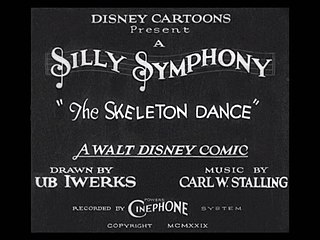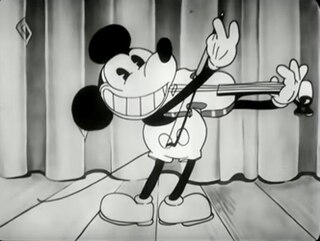
Mickey Mouse is an American cartoon character co-created in 1928 by Walt Disney and Ub Iwerks. The longtime icon and mascot of The Walt Disney Company, Mickey is an anthropomorphic mouse who typically wears red shorts, large yellow shoes, and white gloves. Inspired by such silent film personalities as Charlie Chaplin and Douglas Fairbanks, Mickey is traditionally characterized as a sympathetic underdog who gets by on pluck and ingenuity in the face of challenges bigger than himself. The character's depiction as a small mouse is personified through his diminutive stature and falsetto voice, the latter of which was originally provided by Disney. Mickey is one of the world's most recognizable and universally acclaimed fictional characters.

Plane Crazy is a 1928 American animated short film directed by Walt Disney and Ub Iwerks. The cartoon, released by the Walt Disney Studios, was the first appearance of Mickey Mouse and his girlfriend Minnie Mouse, and was originally a silent film. It was given a test screening to a theater audience on May 15, 1928, and an executive from Metro-Goldwyn-Mayer saw the film, but failed to pick up a distributor. Later that year, Disney released Mickey's first sound cartoon, Steamboat Willie, which was an enormous success; Plane Crazy was officially released as a sound cartoon on March 17, 1929. It was the fourth Mickey film to be given a wide release after Steamboat Willie, The Gallopin' Gaucho and The Barn Dance (1929).

Minnie Mouse is a cartoon character created by The Walt Disney Company. As the longtime sweetheart of Mickey Mouse, she is an anthropomorphic mouse with white gloves, a red or pink bow, blue polka-dotted dress, white bloomers and low-heeled shoes occasionally with ribbons on them. The Mickey Mouse comic strip story "The Gleam" by Merrill De Maris and Floyd Gottfredson first gave her full name as Minerva Mouse, although this is seldom used.
Silly Symphony is an American animated series of 75 musical short films produced by Walt Disney Productions from 1929 to 1939. As the series name implies, the Silly Symphonies were originally intended as whimsical accompaniments to pieces of music. As such, the films usually did not feature continuing characters, unlike the Mickey Mouse shorts produced by Disney at the same time. The series is notable for its innovation with Technicolor and the multiplane motion picture camera, as well as its introduction of the character Donald Duck making his first appearance in the Silly Symphony cartoon The Wise Little Hen in 1934. Seven shorts won the Academy Award for Best Animated Short Film.

The Gallopin' Gaucho is a 1928 American animated short film and the second short film featuring Mickey Mouse to be produced, following Plane Crazy and preceding Steamboat Willie. The Disney studios completed the silent version in August 1928, but did not release it in order to work on Steamboat Willie. The Gallopin' Gaucho was released, with sound, after Steamboat Willie on December 30 of the same year.

The Skeleton Dance is a 1929 Silly Symphony animated short subject produced and directed by Walt Disney and animated by Ub Iwerks. In the film, four human skeletons dance and make music around a spooky graveyard—a modern film example of medieval European "danse macabre" imagery. It is the first entry in the Silly Symphony series. In 1993, to coincide with the opening of Mickey's Toontown in Disneyland, a shortened cover of the cartoon's music was arranged to be featured in the land's background ambiance. The short's copyright was renewed in 1957, and as a published work from 1929 it will enter the US public domain on January 1, 2025.

Wild Waves is a Mickey Mouse short animated film first released on December 18, 1929, as part of the Mickey Mouse film series. It was the fifteenth Mickey Mouse short to be produced, the twelfth of that year, as well as the last to be released by Celebrity Productions before Columbia Pictures took over distribution.

The Opry House is a 1929 Mickey Mouse short animated film released by Celebrity Pictures, as part of the Mickey Mouse film series. It was the fifth Mickey Mouse short to be released, the second of that year. It cast Mickey as the owner of a small theater. Mickey performs a vaudeville show all by himself. Acts include his impersonation of a snake charmer, his dressing in drag and performing a belly dance, his caricature of a Hasidic Jew and, for the finale, a piano performance of Hungarian Rhapsody No. 2 by Franz Liszt.

The Plowboy is a Mickey Mouse short animated film first released on June 28, 1929, as part of the Mickey Mouse film series. It was the eighth Mickey Mouse short to be produced, the fifth of that year.

The Karnival Kid is a 1929 Mickey Mouse short animated film released by Celebrity Productions, as part of the Mickey Mouse film series. It was directed by Walt Disney and animated by Ub Iwerks, with music by Carl W. Stalling. It was the ninth Mickey Mouse short to be produced, the sixth of that year.

When the Cat's Away is a Mickey Mouse short animated film first released on May 3, 1929, as part of the Mickey Mouse film series. It was directed by Walt Disney and animated by Ub Iwerks and Ben Sharpsteen. It was the sixth Mickey Mouse short to be produced, the third of that year. In this cartoon, Mickey and Minnie are the size of regular mice, and Tom Cat is the size of a person.

Building a Building is a 1933 American animated short film produced by Walt Disney Production and released by United Artists. A remake of the 1928 Oswald the Lucky Rabbit film Sky Scrappers, the cartoon depicts Mickey Mouse working at a construction site under the supervision of Peg-Leg Pete while Minnie Mouse is selling box lunches to the workers. It was directed by David Hand, his first directorial assignment at Disney, and features the voices of Walt Disney as Mickey, Marcellite Garner as Minnie, and Pinto Colvig as Pete. It was the 51st Mickey Mouse short film, and the first of that year.

Fiddlin’ Around is a 1930 animated short film produced by Walt Disney Productions and released by Columbia Pictures as part of the Mickey Mouse film series. It was the sixteenth Mickey Mouse short to be produced, the first of that year.

Get a Horse! is a 2013 American animated comedy short film produced by Walt Disney Animation Studios and directed by Lauren MacMullan. Combining black-and-white hand-drawn animation and color computer animation, the short features the characters of the late 1920s Mickey Mouse cartoons.

Mickey's Steam Roller is a 1934 animated short film produced by Walt Disney Productions and released by United Artists. In the cartoon, Mickey Mouse is the driver of a steamroller which is hijacked by his two nephews. It was directed by David Hand and features the voices of Walt Disney as Mickey and Marcellite Garner as Minnie Mouse and Mickey's nephews. It was the 67th Mickey Mouse short film to be released, and the fifth of that year.

Mickey & Minnie's Runaway Railway is a trackless dark ride located in the Walt Disney World Resort in Bay Lake, Florida, and in Disneyland Resort in Anaheim, California. The attraction, the first Mickey Mouse-themed ride-through attraction at a Disney theme park, features an original story based on the stylized world from the Paul Rudish television series.

The Cactus Kid is a Mickey Mouse short animated film first released on May 10, 1930, as part of the Mickey Mouse film series. It was the eighteenth Mickey Mouse short to be produced, the third of that year.

Traffic Troubles is a Mickey Mouse short animated film first released on March 7, 1931, as part of the Mickey Mouse film series. It was the twenty-sixth Mickey Mouse short to be produced, and the second of that year.
The Delivery Boy is a 1931 Mickey Mouse animated short film directed by Burt Gillett, produced by Walt Disney Productions and distributed by Columbia Pictures. It was the twenty-ninth short in the Mickey Mouse film series, and the fifth of that year.
The Shindig is a Mickey Mouse short animated film first released on July 11, 1930, as part of the Mickey Mouse film series. It was the twentieth Mickey Mouse short to be produced, the fifth of that year.



















